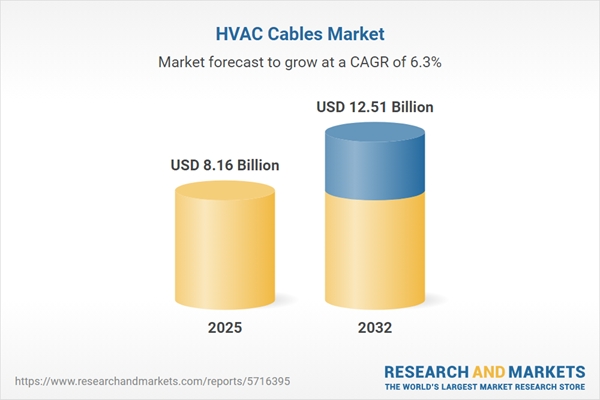Speak directly to the analyst to clarify any post sales queries you may have.
Senior decision-makers in the HVAC cables market are navigating increasing complexity as compliance, reliability, and adaptability become central to project outcomes. As building infrastructure evolves, procurement strategies that anticipate regulatory developments and technological changes are essential to sustaining operational resilience.
Market Snapshot: HVAC Cables Market Growth and Outlook
The global HVAC cables market is valued at USD 7.67 billion in 2024 and is expected to achieve a compound annual growth rate (CAGR) of 6.31%. This growth is attributed to sustained infrastructure investment, shifting regulations, and a greater focus on energy-efficient system designs. Executive leadership is recalibrating procurement to incorporate modern cable technologies, ensuring solutions that keep pace with changing compliance and performance standards. The evolving market landscape presents opportunities to optimize reliability and asset longevity by prioritizing advanced, compliant HVAC cabling solutions.
Scope & Segmentation: Strategic Alignment in the HVAC Cables Market
In-depth segmentation empowers leadership teams to align resource allocation and procurement with business objectives, managing risk and extracting value from targeted investments. Strategic segmentation provides actionable data for process optimization and competitive positioning in the HVAC cables sector.
- Voltage Rating: High, medium, and low voltage cables enable specification for commercial buildings, industrial operations, and residential environments, optimizing infrastructure investments and system adaptability across applications.
- Conductor Material: Options such as copper, aluminum, nickel, and stainless steel alloys deliver cost flexibility and operational reliability, supporting project lifespan and performance targets.
- Insulation Type: PVC, XLPE, EPDM, silicone, and engineered rubber insulation solutions are designed for compliance with evolving safety requirements and protection against diverse technical conditions.
- Application: HVAC cable systems are integral for use across commercial, industrial, and residential sectors, ensuring broad compatibility and installation flexibility for varying levels of project complexity.
- Product Type: Mineral insulated, fiberglass Inconel, and thermocouple cable types (J, K, T) address both routine operational needs and highly specialized technical demands within modern HVAC environments.
- Regions Analyzed: Comprehensive analysis by Americas, Europe, Middle East & Africa, and Asia-Pacific uncovers key distinctions in infrastructure initiatives, regulatory requirements, and market uptake, informing tailored regional strategies.
- Key Companies Covered: Industry benchmarks include Prysmian S.p.A., Nexans S.A., Sumitomo Electric Industries, LS Cable & System, Furukawa Electric, Southwire Company, Belden Inc., Encore Wire, Superior Essex, and NKT A/S, assessed on criteria such as sourcing, technology leadership, and market reach.
Key Takeaways for Senior Decision-Makers
- Adoption of innovative conductor and insulation materials improves cable reliability and extends service life, especially for technically demanding infrastructures.
- Integrating digital monitoring and smart diagnostics enables predictive maintenance and system management, supporting proactive responses to potential issues and safeguarding operational continuity.
- Sustainable sourcing practices and comprehensive lifecycle management anchor procurement to corporate responsibility goals and environmental compliance mandates.
- Procurement strategies must account for distinct regional priorities, with North America emphasizing electrical grid modernization, EMEA focusing on regulatory adherence, and Asia-Pacific scaling infrastructure for urban and industrial growth.
- Modular cable designs facilitate cost-effective upgrades and agile response to regulatory or technological shifts, reducing the impact of future transitions on legacy installations and supporting future-readiness.
- Investment in workforce training and advanced analytics for asset management contributes to improved compliance and preserves the value of capital expenditures on HVAC cable systems.
Tariff Impact: Navigating Evolving Procurement Dynamics
Recent adjustments to U.S. domestic tariffs have led many HVAC cable market participants to reevaluate supplier networks and sourcing models. To maintain supply chain performance and mitigate risk, organizations are diversifying suppliers, developing stronger regional partnerships, and reinforcing continuity strategies. This requires agility in both procurement decisions and logistical planning to ensure uninterrupted operations in a dynamic policy environment.
Methodology & Data Sources
This report is based on synthesis of technical product reviews, tracking of regulatory developments, and field surveys, complemented by analysis from industry experts. Findings are tailored for clarity and practical value to executive decision-makers, reflecting real-world conditions and strategic needs in the HVAC sector.
Why This Report Matters
- Enables leadership to recalibrate HVAC cable strategies rapidly in response to changing technology and regulatory landscapes, maintaining competitive positioning.
- Provides benchmarks for vendor assessment, risk mitigation, and streamlined procurement across a variety of project scopes and technical requirements.
- Promotes best practices in sustainable operations, compliance, and asset management, maximizing value from procurement through long-term system performance.
Conclusion
With reliable HVAC cable market intelligence, organizations can inform procurement choices, remain compliant with evolving standards, and reinforce operational resilience amid sector complexity.
Additional Product Information:
- Purchase of this report includes 1 year online access with quarterly updates.
- This report can be updated on request. Please contact our Customer Experience team using the Ask a Question widget on our website.
Table of Contents
3. Executive Summary
4. Market Overview
7. Cumulative Impact of Artificial Intelligence 2025
Companies Mentioned
The companies profiled in this HVAC Cables market report include:- Prysmian S.p.A.
- Nexans S.A.
- Sumitomo Electric Industries, Ltd.
- LS Cable & System Ltd.
- Furukawa Electric Co., Ltd.
- Southwire Company, LLC
- Belden Inc.
- Encore Wire Corporation
- Superior Essex Inc.
- NKT A/S
Table Information
| Report Attribute | Details |
|---|---|
| No. of Pages | 193 |
| Published | October 2025 |
| Forecast Period | 2025 - 2032 |
| Estimated Market Value ( USD | $ 8.16 Billion |
| Forecasted Market Value ( USD | $ 12.51 Billion |
| Compound Annual Growth Rate | 6.3% |
| Regions Covered | Global |
| No. of Companies Mentioned | 11 |









